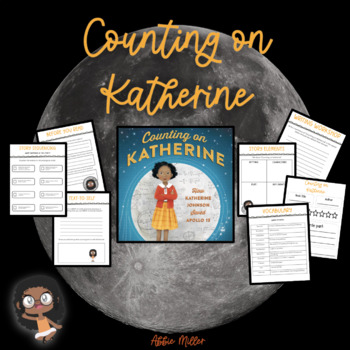Counting on Katherine - Book Companion
Totally Crushin' it in Third
80 Followers
Grade Levels
2nd - 4th, Homeschool
Resource Type
Standards
CCSSRI.3.1
CCSSRI.3.2
CCSSRI.3.3
CCSSRI.3.7
CCSSRI.3.8
Formats Included
- PDF
Pages
32 pages
Totally Crushin' it in Third
80 Followers
What educators are saying
This went right along with the Wit & Wisdom space unit. It was an additional space related book about a woman in science, which is what I needed to help supplement our lesson.
Also included in
- This bundle includes 10 different book companions related to Black History Month. AR information included! You could either print these items or add text boxes and assign a copy for each student for remote students. (File Types Vary*)Price $21.60Original Price $27.00Save $5.40
Description
This PDF resource includes 21 worksheets/activities to use with the story Counting on Katherine by Helaine Becker.
*answer keys included*
Activities include:
2 Before You Read pages
Vocabulary
Ask & Answer Questions (reading strategy)
Character Traits
Text-to-Self prompt
Genre
Text Structure
2 Story Sequencing pages
Comprehension Questions
Inference Questions
Theme
Story Elements
Meet the Author
Write to the Author
Writing Prompt
Research Project
Letter to Katherine
Book Cover Design
Book Review
Clipart by: Lime & Kiwi Designs
Total Pages
32 pages
Answer Key
Included
Teaching Duration
N/A
Report this resource to TPT
Reported resources will be reviewed by our team. Report this resource to let us know if this resource violates TPT’s content guidelines.
Standards
to see state-specific standards (only available in the US).
CCSSRI.3.1
Ask and answer questions to demonstrate understanding of a text, referring explicitly to the text as the basis for the answers.
CCSSRI.3.2
Determine the main idea of a text; recount the key details and explain how they support the main idea.
CCSSRI.3.3
Describe the relationship between a series of historical events, scientific ideas or concepts, or steps in technical procedures in a text, using language that pertains to time, sequence, and cause/effect.
CCSSRI.3.7
Use information gained from illustrations (e.g., maps, photographs) and the words in a text to demonstrate understanding of the text (e.g., where, when, why, and how key events occur).
CCSSRI.3.8
Describe the logical connection between particular sentences and paragraphs in a text (e.g., comparison, cause/effect, first/second/third in a sequence).



